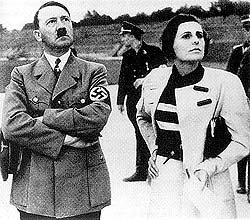
Starship Troopers (1997) is a movie I keep revisiting. It has all along its surface a shine that I cannot resist; I want to run my hand along it, like the swoop of a 1950s car bumper. The movie has a lithe, garish glee that provides the viewer with ample opportunity to indulge in special effects that are alternately nubile and berserk.
Paul Verhoeven and his screenwriter, Ed Neumeier, who together gave us 1987's Robocop, pulled off a famous sly one here. Starship Troopers was greeted with mixed responses--prompting Neumeier in 2003 to write a letter to the Hollywood Investigator, which had drawn parallels between Starship Troopers and "post-9/11 war hysteria." Neumeier congratulated the writer who, as Neumeier put it, "clearly understood what we were up to"; he also admitted, though, that "we may have suffered when Starship Troopers was initially released because we were not willing to underline for the audience and critics that this was, in fact, a movie about the dangers of fascism." The impression he leaves is that he and Verhoeven thought the satire would be obvious--but this is disingenuous, albeit in a good way, because Starship Troopers moves just like their earlier venture, Robocop. That movie, too, plays it both ways: as a comfortably zero-brain-required ultraviolent action flick and a savage satire of post-1960s cop movies.
 Is this fair? Are the filmmakers scolding our desire for the clear lines of--well, if not outright fascism, at least an orderly, healthy, brightly lit world--with one hand, while scooping up the green with the other? Well, yes and yes. I am attracted to Starship Troopers because of that double-duty manipulation. I'm glad to watch a movie nimble enough to amuse and dismay, excite and repulse. Starship Troopers keeps us on our toes, and reminds me once again we have to be very careful when we watch a movie.
Is this fair? Are the filmmakers scolding our desire for the clear lines of--well, if not outright fascism, at least an orderly, healthy, brightly lit world--with one hand, while scooping up the green with the other? Well, yes and yes. I am attracted to Starship Troopers because of that double-duty manipulation. I'm glad to watch a movie nimble enough to amuse and dismay, excite and repulse. Starship Troopers keeps us on our toes, and reminds me once again we have to be very careful when we watch a movie.I love the term camera obscura, the "dark room" with a tiny hole in one wall that projects the outside world upside-down on the opposite wall. This goes all the way back to fifth century B.C.E. China, but Aristotle, Islamic scholars, Da Vinci, and finally Johannes Kepler, who gave us the term camera obscura, all fooled around with this optical dynamite. And considering that the device has often been used for safely viewing solar eclipses, I cannot ignore that the layers of metaphor here are satisfying.
Starship Troopers fits nicely into these layers, a trick of light that shows us objects clearly but inverted. Our job is to keep watching, but also do the hard work of craning our necks to see how the mirrors re-vert the image so that we can watch in misleading comfort. I have a cousin who, when he was a kid and wanted to stay up late to watch a movie, would sit in a cramped position so that he wouldn't fall asleep. There is a lesson here, especially if you're up past your bedtime to watch something as satisfyingly duplicitous as Starship Troopers.
(Below: a stereoscopic slide of a camera obscura in Philadelphia's Fairmont Park, circa 1870.)

1 comment:
Starship troopers is good, especially the propaganda films at the start and end, but the book is also going to better, particularly at achieving what you talk about in this post.
Post a Comment